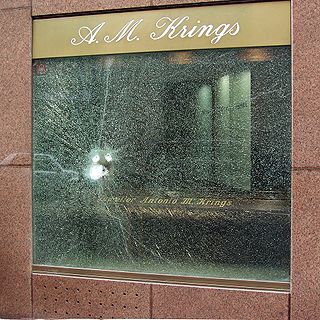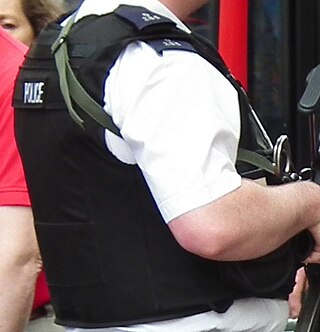
A gambeson is a padded defensive jacket, worn as armour separately, or combined with mail or plate armour. Gambesons were produced with a sewing technique called quilting. They were usually constructed of linen or wool; the stuffing varied, and could be for example scrap cloth or horse hair. During the 14th century, illustrations usually show buttons or laces up the front.

A bulletproof vest, also known as a ballistic vest or a bullet-resistant vest, is an item of body armor that helps absorb the impact and reduce or stop penetration to the torso from firearm-fired projectiles and fragmentation from explosions. The vest may come in a soft form, as worn by many police officers, prison guards, security guards, and some private citizens, used to protect against stabbing attacks or light projectiles, or hard form, using metallic or para-aramid components. Soldiers and police tactical units wear hard armors, either in conjunction with soft armor or alone, to protect against rifle ammunition or fragmentation.

To improve motorcycle safety many countries mandate the wearing of personal protective equipment such as protective clothing and helmets. Protective clothing may include certain types of jackets, gloves, boots, and pants. Jackets meant for motorcyclists are typically made of leather or specialized man-made fabrics like cordura or Kevlar. These jackets typically include padding on the elbow, spine, and shoulder regions. This was once quite bulky, but modern technology and materials have made it unobtrusive. Gloves are generally made of leather or Kevlar and some include carbon fiber knuckle protection. Boots, especially those for sport riding, include reinforcement and plastic caps on the ankle and toe areas. Pants are usually leather, cordura, or Kevlar. Except for helmets, none of these items are required by law in any state in the USA, or in any part of the UK but are recommended by many of those who ride.

Plate armour is a historical type of personal body armour made from bronze, iron, or steel plates, culminating in the iconic suit of armour entirely encasing the wearer. Full plate steel armour developed in Europe during the Late Middle Ages, especially in the context of the Hundred Years' War, from the coat of plates worn over mail suits during the 14th century.

Bulletproof glass, ballistic glass, transparent armor, or bullet-resistant glass is a strong and optically transparent material that is particularly resistant to penetration by projectiles. Like any other material, it is not completely impenetrable. It is usually made from a combination of two or more types of glass, one hard and one soft. The softer layer makes the glass more elastic, so that it can flex instead of shatter. The index of refraction for all of the glasses used in the bulletproof layers must be almost the same to keep the glass transparent and allow a clear, undistorted view through the glass. Bulletproof glass varies in thickness from 3⁄4 to 3+1⁄2 inches.

A flak jacket or flak vest is a form of body armor. A flak jacket is designed to provide protection from case fragments ("frag") from high explosive weaponry, such as anti-aircraft artillery, grenades fragments, some types of pellets used in shotguns, and other lower-velocity projectiles. It is not designed to protect against bullets fired from most small arms such as rifles or handguns. However flak jackets are able to sustain certain gunshots, depending on the angle at which the shot was fired, the caliber of the bullet, the speed of the projectile and the range from which the shot was fired.

Body armor, also known as body armour, personal armor or armour, or a suit or coat of armor, is protective clothing designed to absorb or deflect physical attacks. Historically used to protect military personnel, today it is also used by various types of police, private security guards or bodyguards, and occasionally ordinary civilians. Today there are two main types: regular non-plated body armor for moderate to substantial protection, and hard-plate reinforced body armor for maximum protection, such as used by combat soldiers.

Bulletproofing is the process of making an object capable of stopping a bullet or similar high velocity projectiles. The term bullet resistance is often preferred because few, if any, practical materials provide complete protection against all types of bullets, or multiple hits in the same location, or simply sufficient kinetic (movement) energy to overcome it.

The Small Arms Protective Insert (SAPI) is a ceramic ballistic plate used by the United States Armed Forces. It was first used in the Ranger Body Armor and Interceptor Body Armor, both are ballistic vests. It is now also used in the Improved Outer Tactical Vest as well as the Modular Tactical Vest, in addition to commercially available "plate carriers". The Kevlar Interceptor vest itself is designed to stop projectiles up to and including 9×19mm Parabellum submachine gun rounds, in addition to fragmentation. To protect against higher-velocity rifle rounds, SAPI plates are needed.

A stab vest or stab proof vest is a reinforced piece of body armor, worn under or over other items of clothing, which is designed to resist knife attacks to the chest, back and sides. Stab vests are different from bulletproof vests, most of which offer protection against firearms but afford little against stabbing with sharp-tipped objects such as knives; most stab vests afford less protection against bullets, particularly those of high caliber, but are designed to prevent serious injury by prohibiting knife penetration beyond a few millimeters. Stab vests are also needle and slash proof.

A ballistic shield, also called a tactical shield or bulletproof shield, is a protection device deployed by police, paramilitaries, and armed forces that are designed to stop or deflect bullets and other projectiles fired at their carrier. Ballistic shields also protect from less serious threats such as thrown items. Ballistic shields are similar to riot shields, but offer greater protection and are typically used by special units or in situations where riot shields would not offer adequate protection.

The Army Combat Shirt (ACS) is a flame-resistant shirt developed and used by the United States Army as a supplementary addition to the Army Combat Uniform. The ACS is a stand-alone shirt designed specifically for use with Improved Outer Tactical Vest armor in warm and hot weather instead of the blouse. It is intended to greatly increase user comfort through the use of lightweight, moisture-wicking, and breathable fabrics. The ACS was created in conjunction with the USMC's Flame Resistant Organizational Gear (FROG). The ACS, in conjunction with the Fire Resistant ACU (FRACU) trousers, provides head-to-toe protection against burns.
Miguel Caballero S.A.S. is an international protective clothing company based in Bogotá, Colombia, operating branches in Mexico and Guatemala. The company specialises in fashionable armored clothing. Notable clients include King Felipe VI of Spain, Michael Bloomberg, former Colombian president Álvaro Uribe, former Venezuelan President Hugo Chávez, former U.S. President Barack Obama, and former Mexican President Enrique Peña Nieto.

A ballistic face mask, also known as facial armor, is a type of personal armor designed to protect the wearer's face from ballistic threats. Ballistic face masks are usually made of Kevlar or other bullet resistant materials and the inside of the mask may be padded for shock absorption, depending on the design.

The Improved Outer Tactical Vest (IOTV) is an enhanced version of, and a replacement for, the older Outer Tactical Vest (OTV) variant of the Interceptor Multi-Threat Body Armor System, as fielded by the United States Army. The IOTV is compatible with the Deltoid and Axillary Protector System (DAPS) components, ESAPI, Enhanced Side Ballistic Inserts (ESBI), as well as the OTV's groin protector. It has a flame-resistant standalone shirt, the Army Combat Shirt, designed specifically for use with the IOTV.

The use of personal protective equipment (PPE) is inherent in the theory of universal precaution, which requires specialized clothing or equipment for the protection of individuals from hazard. The term is defined by the Occupational Safety and Health Administration (OSHA), which is responsible for PPE regulation, as the "equipment that protects employees from serious injury or illness resulting from contact with chemical, radiological, physical, electrical, mechanical, or other hazards." While there are common forms of PPEs such as gloves, eye shields, and respirators, the standard set in the OSHA definition indicates a wide coverage. This means that PPE involves a sizable range of equipment. There are several ways to classify them such as how gears could be physiological or environmental. The following list, however, sorts personal protective equipment according to function and body area.

Propper is a manufacturer of clothing and gear for tactical, law enforcement, public safety, and military applications. Since 1967 it has been one of the main uniform suppliers to the United States military.
Armor has been used in the military for a long period of time during the course of history, but is becoming more frequently seen in the public sector as time passes. There are many different forms and ways that armor is being commercially used throughout the world today. The most popular and well-known uses are body and vehicle armor. There are other commercial uses including aircraft armor and armored glass.














